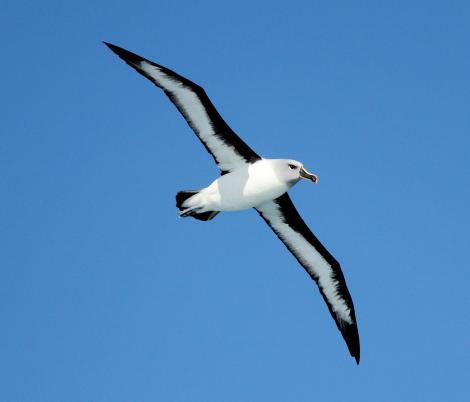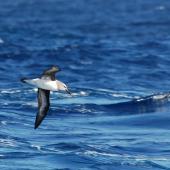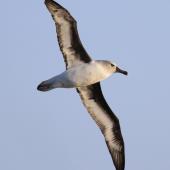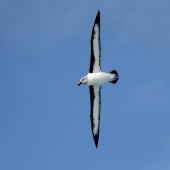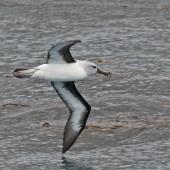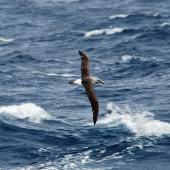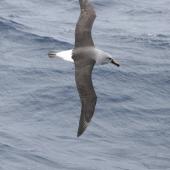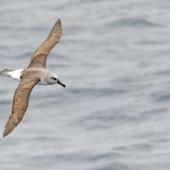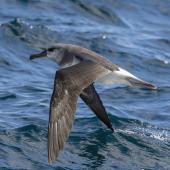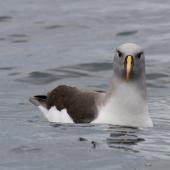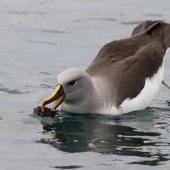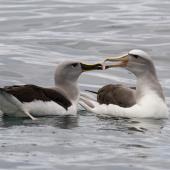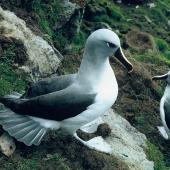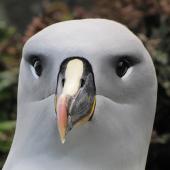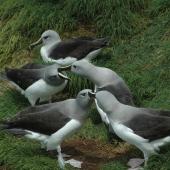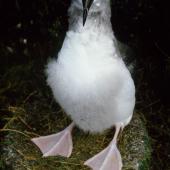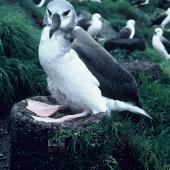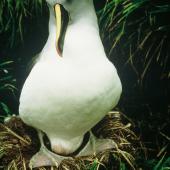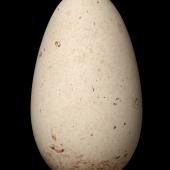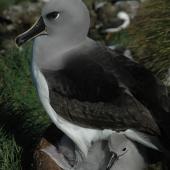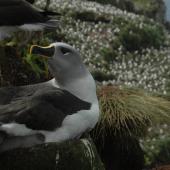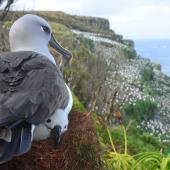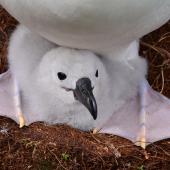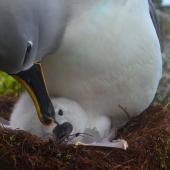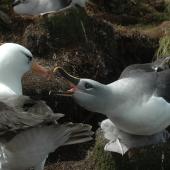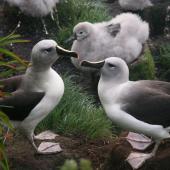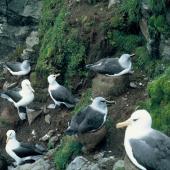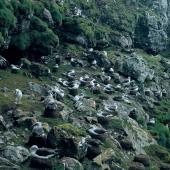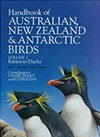Grey-headed mollymawk | Toroa
Thalassarche chrysostoma (J.R. Forster, 1785)
Order: Procellariiformes
Family: Diomedeidae
New Zealand status: Native
Conservation status: Nationally Vulnerable
Other names: grey-headed albatross, grey headed mollymawk, greyheaded mollymawk, grey headed albatross, greyheaded albatross
Geographical variation: Nil
The grey-headed mollymawk is one of 12 species of albatross to nest in New Zealand. Its striking grey-and-white plumage, and bright bill markings make it one of the most beautiful of the marine birds. It is a bird of cold, deep water, and is therefore a rare sight around the New Zealand mainland. Most claimed sightings are likely to be of the very similar-looking Buller’s mollymawk.
Unlike most albatrosses, grey-headed mollymawks show little interest in boats. They prefer very low-productivity zones in the ocean, and from their breeding site at Campbell Island make the 1500 km trek to the richer waters of the Polar Front, between New Zealand and Antarctica to feed on squid and fish.
Identification
The grey-headed mollymawk is a large white-bodied bird with handsome grey head plumage. Their black-and-yellow bill is striking, with brownish-black side-plates and bright yellow plates above and below the bill. The bill is hooked, with prominent nostrils, and may have a reddish tint on the curve of the bill hook. The back and upper wings are brownish-black, as is the tail. The distinguishing feature from other similar small albatrosses is the underwing, which is white with a broad dark leading edge particularly into the ‘elbow’. Other similar species have more white on the underwing. Juveniles have a completely dark bill, but are otherwise similar to adults, though often with a diagnostic whitish patch on the cheek contrasting with the otherwise dark head. As their plumage wears, the head becomes white, leaving a grey partial collar. In this plumage they may be indistinguishable from immature black-browed and Campbell black-browed mollymawks, although these usually have a bi-coloured bill, darker at the tip, cf. the all-dark bill of immature grey-headed mollymawks
Voice: a braying call, repeated nap-nap-nap sound, and at times sounds like a small chainsaw starting.
Similar species: Buller’s mollymawk has whitish cap, a broader base to the yellow upper bill, and a narrower dark leading edge to the underwing. Atlantic yellow-nosed mollymawk is a slimmer build, has a longer, slimmer bill with no yellow on the lower mandible, a paler grey head, and a much whiter underwing. Some ‘white-headed’ immature grey-headed mollymawks may be indistinguishable from immature black-browed and Campbell black-browed mollymawks (see above).
Distribution and habitat
Grey-headed mollymawks are found around the Southern Ocean, with a circumpolar breeding distribution. They nest on coastal cliffs in the same areas as black-browed mollymawks and Campbell black-browed mollymawks, often on the margins of their colonies. They tend to be solitary at sea, and don’t follow vessels or scavenge on fisheries waste to the same extent as many other small albatrosses. In the New Zealand region, they nest at Campbell Island and on nearby Macquarie Island.
Their feeding habitat tends to be oceanic (>2000 m water depth) rather than over continental shelves and they occur in the New Zealand region mainly well offshore and south of Cook Strait, but may be found around East Cape, particularly during the austral autumn.
Population
The population on Campbell Island has been monitored sporadically since the 1940s, and showed a major decrease in numbers during the 1970s and 1990s. Around 6,600 breeding pairs are currently present; allowing for a similar number of pre-breeders, this is about 10% of the global population of c.250,000 birds.
Threats and conservation
There are currently no introduced mammals on Campbell Island, which is the only site where grey-headed mollymawks breed in New Zealand (Norway rats and previously feral cats were present until eradicated in 2001). The main threats are likely to result from changes in food availability within foraging distance from Campbell Island, if birds need to fly further while feeding chicks. Movement of the Polar Front away from Campbell Island is thought to have been the cause of the massive population decline on Campbell Island in the mid-to-late 20th Century. Occasional incidental mortality has been recorded in longline fisheries, but it is rare for grey-headed mollymawks to be caught (unlike several other albatross species). The conservation status of this species in New Zealand was moved from nationally critical to nationally vulnerable in 2013 while the global IUCN Red List threat status was changed from globally vulnerable to globally endangered in 2013.
Breeding
Grey-headed mollymawks form long-term monogamous pairs, and (unlike most mollymawks) typically breed only once every 2 years. They return to the colony in September, and the single egg (107 x 67 mm) is laid in October. Incubation is shared and takes about 72 days, with the egg hatching in January or February. The chick is fed by regurgitation by both parents, and fledges at a mean age of 141 days-old, in about May. This September to May breeding cycle is only 3 weeks longer than Campbell Island black-browed mollymawks breeding at the same site (which fledge their chicks at 120-125 days-old), but this is apparently enough of a difference to require grey-headed mollymawks to take a break of 16 months to complete their moult before breeding again, cf. 5 months for the annually-breeding Campbell Island black-browed mollymawks. Grey-headed mollymawks first breed when 8-20 years-old, and may live for 30 or more years.
Behaviour and ecology
Grey-headed mollymawks are solitary at sea, although they may raft in small groups. They are poor divers (to less than 6 m water depth) and feed by scavenging mainly at the surface. During breeding, birds on foraging trips from Campbell Island often flew to the Polar Front, which lies 1000-1500 km south of Campbell Island.
Food
The diet of grey-headed mollymawks on Campbell Island consisted mainly of squid, in particular species associated with the Polar Front. Fish (e.g. southern blue whiting) were also consumed. Grey-headed mollymawks elsewhere consume a lot of krill, but this was a minor component of the diet at Campbell Island.
Websites
References
Cherel, Y.; Klages, N.T. 1998. A review of the food of albatrosses. Pp 113-136 in Robertson, G.; Gales, R. (eds) Albatross: biology and conservation. Surrey Beatty & Sons Pty Ltd, Chipping Norton.
del Hoyo, J.; Elliott, A.; Sargatal, J. (eds) 1992. Handbook of the birds of the world. Vol. 1. Ostrich to ducks. Lynx Edicions, Barcelona.
Marchant, S.; Higgins, P.J. (eds) 1990. Handbook of Australian, New Zealand and Antarctic birds. Vol.1, ratites to ducks. Oxford University Press, Melbourne.
Prince, P.A.; Huin, N.; Weimerskirch, H. 1994. Diving depths of albatrosses. Antarctic Science 6: 353-354.
Robertson, H.A; Baird, K.; Elliott, G.P.; Hitchmough, R.A.; McArthur, N.J.; Makan, T.; Miskelly, C.M.; O’Donnell, C.F.J.; Sagar, P.M.; Scofield, R.P.; Taylor, G.A.; Michel, P. 2021. Conservation status of birds in Aotearoa New Zealand birds, 2021. New Zealand Threat Classification Series 36. Wellington, Department of Conservation. 43p.
Waugh, S.M.; Weimerskirch, H.; Cherel, Y.; Prince, P.A. 2000. Contrasting strategies of provisioning and chick growth in two sympatrically breeding albatrosses at Campbell Island, New Zealand. Condor 102: 804-813.
Waugh, S.M.; Weimerskirch, H.; Cherel, Y.; Shankar, U.; Prince, P.A.; Sagar, P.M. 1999. Exploitation of the marine environment by two sympatric albatrosses in the Pacific Southern Ocean. Marine Ecology - Progress Series 177: 243-254.
Waugh, S.M.; Weimerskirch, H.; Moore, P.J.; Sagar, P.M. 1999. Population dynamics of black-browed and grey-headed albatrosses Diomedea melanophrys and D. chrysostoma at Campbell Island, New Zealand, 1942-96. Ibis 141: 216-225.
Recommended citation
Waugh, S.M. 2013 [updated 2022]. Grey-headed mollymawk | toroa. In Miskelly, C.M. (ed.) New Zealand Birds Online. www.nzbirdsonline.org.nz
Grey-headed mollymawk | Toroa
- Social structure
- monogamous
- Breeding season
-
- Jul
- Aug
- Sep
- Oct
- Nov
- Dec
- Jan
- Feb
- Mar
- Apr
- May
- Jun
- Nest type
- pedestal
- Nest description
- Pedestal nest is built on over successive years from mud and grass.
- Nest height (mean)
- 0 m
- Maximum number of successful broods
- 1
- Clutch size (mean)
- 1
- Mean egg dimensions (length)
- 106.8 mm
- Mean egg dimensions (width)
- 67.3 mm
- Egg colour
- Creamy white with occasional brown speckles at the rounded end
- Egg laying dates
-
- Jul
- Aug
- Sep
- Oct
- Nov
- Dec
- Jan
- Feb
- Mar
- Apr
- May
- Jun
- Interval between eggs in a clutch
- Not applicable days
- Incubation behaviour
- shared
- Nestling type
- altricial
- Nestling period (mean)
- 72 days
- Age at fledging (mean)
- 141 days
- Age at independence (mean)
- 141 days
- Age at first breeding (typical)
- 8-20 years
- Maximum longevity
- 30 years
- Maximum dispersal
- Highly philopatric




